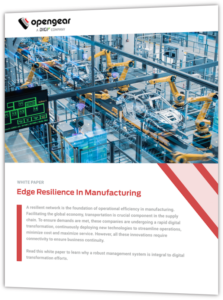The 4th industrial revolution and the pandemic are just two factors that have drastically changed the manufacturing landscape. Increased competition, shrinking margin sizes, and evolving customer demands have forced manufacturers to evaluate their operational efficiency, a critical necessity as they embark on digital transformation. The foundation for ensuring these ongoing efforts are successful is a resilient network. The global industrial automation market is projected to be worth $200 billion. These technological advancements have created many improvements in a variety of sectors, with manufacturing being one that has greatly benefitted. This is mainly because automation allows manufacturers’ to gain greater control of their operations by increasing production capacity, reducing costs by streamlining their production processes, and more. What does automation in manufacturing actually refer to though? It’s the use of technologies, which could be equipment and software, to automate production processes. Manufacturing processes are very diverse, which means there are many different types of automation that can be implemented for each aspect of production.
Types of Manufacturing Automation
The manufacturing process is highly diverse, so there’s no surprise that there are many different types of automation to cater to each component.
Fixed Automation
Also known as hard automation, fixed automation is generally a system where manufacturing automation is set to produce a single product within individual machines. It’s usually used for producing large quantities and has a high barrier of entry. Most times, it involves a set of repetitive or fixed sequences, as the name would imply, like the assembly or processing of a product. It provides automatic control equipment for greater flexibility in making product design changes.
Examples of fixed automation include:
- Chemical manufacturing processes
- Assembly lines
- Material conveyor systems
Flexible Automation
Flexible automation allows systems to respond to production changes quickly. To run personnel programs computerized systems can control machines or they can use Human Machine Interfaces (HMIs). Flexible Automation is the ability for a robot or system to be quickly and easily re-tasked to change product design for both low and high-mix manufacturing. When properly utilized, a flexible automation cell can improve efficiency by evolving with your process and demand, reducing and fixing production costs, improving quality, and eliminating health and safety issues.
Examples of flexible automation include:
- Assembly lines
- Robotics
- Material handling systems
Benefits Of Automation In Manufacturing Automation in manufacturing has become a necessity. Requiring little to no human interaction to operate, automated systems streamline the assembly, processing, inspection, and handling of materials. Distributed factories, the lack of on-site staff and a variety of technology stacks have increased the need to automate processes.
Leveraging the benefits that it offers will give you a significant competitive advantage. Some of these benefits include:
- Lower Operating Costs: Although automation may require a significant initial investment, it offers great value for the money in the long run. Depending on the task, just adding one automated machine can free up engineers and employees to focus on other more critical tasks.
- Increased Workplace Safety: Automation allows manufacturers to remove workers far from hazardous processes or substances.
- Increased Productivity: In addition to working unattended 24/7, machines can also maintain the same speed throughout. This means the production process can continue longer and more efficiently. As a result, you can produce more or work on new products without disrupting production.
- Better Product Quality: Generally, machines can perform manufacturing tasks with greater accuracy than people. Moreover, they also maintain the same production quality throughout. With increased conformity and uniformity, you’ll have a lower fraction defect rate.
Manufacturing organizations are optimizing their processes, which begins with implementing new technologies and applications. However, as these are added, a larger strain is placed on the network, increasing the chance of an outage. The Opengear Network Resilience Platform is based on the presence and proximity of a Smart OOB console server at every IT location, centrally orchestrated through Lighthouse management software. The Network Resilience Platform provides secure remote access to your critical network devices through a separate management plane, with the ability to automate processes, such as securely deploying and provisioning equipment and accessing Remote IP devices at any edge location. This platform is the Network Engineer’s Network. Secure remote access, via physical hardware at each location, providing an always-available independent network open only to the core network team; to be used on Day One, for everyday management, and during production network events. Opengear’s Smart Out of Band technology, plus the use of open architecture automation tools (Docker support, Python runtime environment), provides secure access to console ports while also creating a robust management plane.






